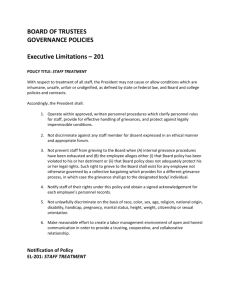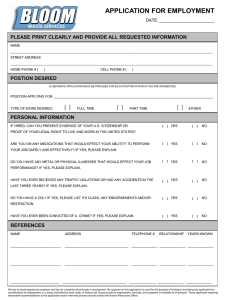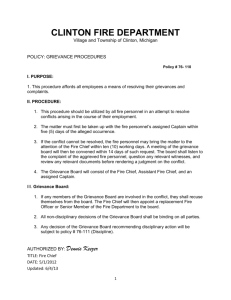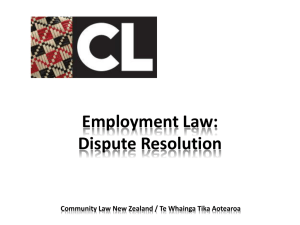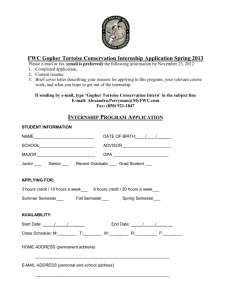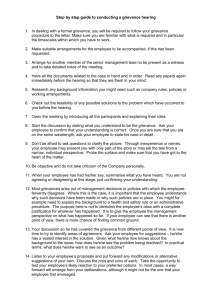CMS 3—Human Resource Management
advertisement
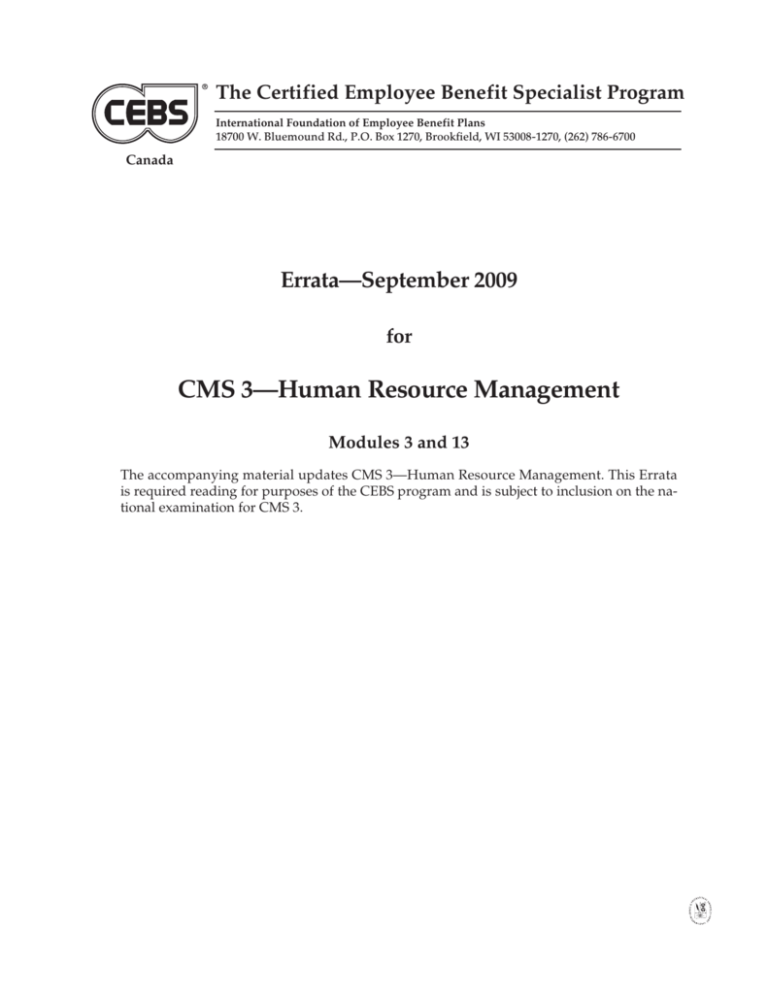
The Certified Employee Benefit Specialist Program International Foundation of Employee Benefit Plans 18700 W. Bluemound Rd., P.O. Box 1270, Brookfield, WI 53008-1270, (262) 786-6700 Canada Errata—September 2009 for CMS 3—Human Resource Management Modules 3 and 13 The accompanying material updates CMS 3—Human Resource Management. This Errata is required reading for purposes of the CEBS program and is subject to inclusion on the national examination for CMS 3. Errata—September 2009 CMS 3—Human Resource Management Module 3—Organization of Work 1. Learning Guide, replace page 3.17. 1 Module 13—Union/Management Relations Text page 583, Types of Strikes 1. Note that the current definition does allow for the possibility that individually or collectively, union leaders may be the catalyst for or support wildcat strike action. Better wording clarifies the legal process that is missed, i.e., “striking without following the proper procedure for striking such as majority approval through a union ballot.” Please replace the definition of wildcat strikes with the following: Wildcat strikes are spontaneous or unannounced illegal actions by a union or a section of employees without following the proper procedure for striking such as majority approval through a union ballot. Usually undertaken in emergent situations where the employer is perceived to be in substantial breach of the collective agreement, relevant legislation, or some other condition deemed critical to the survival of the union. In such situations, the employer usually has the legal right to fire the offending workers and to sue the union for damages provided that the workers’ actions can be demonstrated to be unreasonable under the circumstances. Also called outlaw strike, quickie strike or work stoppage. 2. Learning Guide, replace pages 13.19-13.20. 2 22.Discuss behavioural factors that can affect job analysis results. (p. 150 and pp. 154-155) A number of behavioural factors can affect job analysis results. Job incumbents (managers and/or their employees) may inflate the importance and significance of their jobs because job analysis is used to determine compensation. Both hope that “puffing up” jobs will result in higher pay levels, greater “status” for resumés and more promotion opportunities. Job analysis can also trigger anxiety for both managers and employees. The information gathered through job analysis is used to write job descriptions. Managers may worry that employee job descriptions will unrealistically limit their managerial flexibility. They may feel unable to demand certain duties and tasks be performed by an employee if the tasks are specifically excluded from that employee’s job description. Likewise, employees may feel that job analysis could limit their creativity and flexibility by formalizing their duties. 23. What are marginal job functions? How are they determined? (p. 155) Marginal job functions are those duties that are part of the job but are incidental or ancillary to the job’s purpose and nature. For example, the purpose and nature of a bartender’s job is to serve drinks. However, at the end of the day, he or she may also be responsible for putting out empty bottles for recycling. Percentage of time spent on the task, frequency of the task and importance of the task are factors that determine whether a task is an essential or a marginal job function. 24.Distinguish between a job description and job specifications. (pp. 156-157) A job description identifies the tasks, duties and responsibilities of a job. It describes what is done, why it is done, where it is done and, briefly, how it is done. Job specifications list the knowledge, skills and abilities (KSAs) needed to perform a job satisfactorily. KSAs include education, experience, work skill requirements and personal ability, as well as mental and physical requirements. 25. What are the most common components of a typical job description? (pp. 157-160) The first component of a typical job description is the identification of the job—the title, department, reporting relationships, location, pay grade, etc. The second component is a general summary of the job: a concise statement of the general responsibilities and components that make the job different from others. The third component typically lists the essential functions and duties associated with the job. It clearly identifies the major tasks, duties and responsibilities performed. The next component outlines the job specifications. These are typically the desired KSAs, education and experience required, physical requirements and/or working conditions. The final section of the job description often includes approval signatures by appropriate managers and a legal disclaimer. This disclaimer allows employers to change employees’ job duties or to request employees to perform duties not listed, so that the job description is not viewed as a contract between the employer and employee. Module 3: Organization of Work CMS3-9/09 3.17 notes 3.18 CMS3-9/09 CMS 3: Human Resource Management 25.Identify the five types of strikes that can occur. (p. 583) Economic strikes happen when parties fail to reach an agreement during collective bargaining. Unfair labour practice strikes occur when union members walk away from their jobs over what they feel are illegal employer actions, such as a refusal to bargain. Jurisdictional strikes happen when members of one union walk out to force the employer to assign work to them instead of to members of another union. Sympathy strikes take place when one union chooses to express support for another union involved in a dispute. Wildcat strikes are spontaneous or unannounced illegal actions by a union or a section of employees, without following the proper procedure for striking such as majority approval through a union ballot. Usually undertaken in emergent situations where the employer is perceived to be in substantial breach of the collective agreement, relevant legislation, or some other condition deemed critical to the survival of the union. In such situations, the employer usually has the legal right to fire the offending workers and to sue the union for damages provided that the workers’ actions can be demonstrated to be unreasonable under the circumstances. Also called outlaw strike, quickie strike or work stoppage. 26.Other than strikes, what mechanisms does the union have to exert its bargaining power? (pp. 584-585) If a union is initially unable or unwilling to strike, its members have other mechanisms for pressuring employers. A common method is picketing; a form of nonviolent resistance in which people congregate outside a place of work or location where an event is taking place in an attempt to dissuade others from going in. It is only lawful to picket when there is no collective agreement in place. Secondary picketing occurs when economic pressures are put on other employers or persons impacted with some kind of relationship with the first employer to induce them to use their influence to settle the contract dispute. Boycotting is another mechanism. It is used to encourage others to refuse to patronize an employer. Unions can also use their financial solvency for leverage. If the union has substantial financial backing, members are more confident that it can sustain its ground for as long as needed. Also, other unions may be called upon for support. 27. What is the typical division of responsibilities between the HR unit and managers with regards to grievance management? (p. 588) The responsibilities of the HR unit with regards to grievance management typically include: (a) Assisting in designing the grievance procedure (b) Monitoring trends in grievance rates for the organization (c) In some cases, assisting in preparing grievance cases for arbitration (d) In some cases, settling grievances. The HR responsibilities of managers typically include: (a) Operating within provisions of the grievance procedure (b) Attempting to resolve grievances where possible (c) Documenting grievance cases for the grievance procedure (d) Engaging in grievance prevention efforts. Module 13: Union/Management Relations CMS3-9/09 13.19 notes 13.20 CMS3-9/09 CMS 3: Human Resource Management
